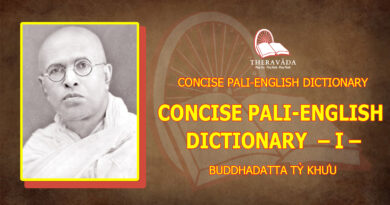Catupaṭisambhidā In Theravāda Buddhism – 3. Analytical Knowledge Of Cause (eng)
CATUPAṬISAMBHIDĀ IN THERAVĀDA BUDDHISM – 3. ANALYTICAL KNOWLEDGE OF CAUSE
The analytical knowledge of cause or Dhammapaṭisambhidā, being under discussion, is the second in the series of the fourfold analytical knowledge, and comes after the analytical knowledge of result just discussed in the chapter two. It will be represented in the typical pattern of the explanation illustrated in the preceding knowledge. At the outset, the term ‘dhamma’ is generally explained. The explanation is then followed by the classification, clarification and exegesis of the same term confined in the scope of dhammapaṭisambhidā. After that, significant qualities of dhammapaṭisambhidā are shown to characterize the nature of the knowledge.
1. Meanings of ‘Dhamma’
‘Dhamma’ is a Pāḷi word; its Sanskrit counterpart is ‘dharma’. The latter term definitely comes into existence prior to the former for a long time. In fact, ‘dharma’ can be found in the Bṛhadāraṇyaka Upaniṣad of Yajur Veda,[1] the third of four Vedas, which is considered much older than the Pāḷi literature.
Despite the difference of historical and etymological background, both of them share a visibly common point, the ambiguity related to their philosophical and ethical aspects. As a result, many modern scholars had invested much time and effort in studying the subject-matter comparatively, and proposed different ideas from different frames of thought, philosophy and culture—each of them, of course, bears its own momentous value. The present attempt, however, is not intended to go further on the same track; instead, it confines ‘dhamma’ to the Pāḷi literature and the Buddhist point of view only.
The term ‘dhamma’ perhaps has a widest range of meaning in the Pāḷi literature. The Tipiṭaka Pāḷi-Myanmar Dictionary, one of the most comprehensive dictionaries ever made, compiles more than fifty meanings[2] for ‘dhamma’ with reference to the canonical, commentarial and sub-commentarial literature. Certainly, no equivalent translation of any other language could cover its sense. So, it is usually translated in accordance with the context involved, or kept as it is in some situation.
Because the meanings of ‘dhamma’ compiled in the aforesaid dictionary are too extensive to locate in this paper and too involved in the later texts, the following account will place emphasis on the meanings of ‘dhamma’, which are directly connected with the canonical literature only. In addition, the meanings given here are collected by highly respected commentators, and are found in their respective commentarial works.
Etymologically, ‘dhamma’ is a combination of the root √dhar meaning ‘to hold or to bear’ and the noun-forming suffix ‘ma’. The term is defined as “Attano lakkhaṇaṃ dhārentīti dhammā”[3] (those which bear their own nature), or “Atttano sabhāvaṃ dhāretīti dhammo”[4] (that which bears its own nature). This sense could embrace anything without exception—conditioned (saṅkhata) and unconditioned (asaṅkhata)—because the conditioned or unconditioned must undoubtedly ‘bear their own nature’.
Buddhaghosa Thera, in the Dīghanikāya Aṭṭhakathā[5], however, gives four meanings to the term, which are mentioned with reference to the Canonical Texts as follows:
(1) Guṇa (Righteousness), as in “Na hi dhammo adhammo ca, ubho sammavipākino; adhammo nirayaṃ neti, dhammo pāpeti sugatiṃ”[6] (Righteousness and non-righteousness do not have the same consequence, indeed; non-righteousness leads beings to purgatory, righteousness leads beings to happy state).
(2) Desanā (Instruction), as in “Dhammaṃ, vo bhikkhave, desessāmi ādikalyāṇaṃ…”[7] (O Bhikkhus, I am going to give you the instruction, which is excellent at the beginning…).
(3) Pariyatti (Texts), as in “Idha bhikkhu dhammaṃ pariyāpuṇāti suttaṃ geyyaṃ…”[8] (Here, a bhikkhu learns thoroughly the Texts such as discourse in prose, discourse in prose and verse…).
(4) Nissatta (Insubstantial phenomena), as in “Tasmiṃ kho pana samaye dhammā honti, khandhā honti…”[9] (At the time when the insubstantial phenomena arise, aggregates arise…).
In the Dhammasaṅganī Aṭṭhakathā (DhsA. 81), however, Buddhaghosa Thera gives ‘dhamma’ another set of meaning, which is partly similar to the set mentioned above. ‘Desanā’ in the first set is replaced by ‘hetu’ of the second, ‘nissatta’ by ‘nissattanijjīvatā’, and the rest is the same. By combining two set, ‘dhamma’ embraces five meanings—guṇa, desanā, pariyatti, hetu and nissatta or nissattanijjīvatā. Moreover, desanā and pariyatti suggest a single “main implication considered under the two aspects[10] of Doctrine as taught and Doctrine as formulated, we may interpret Dhamma by the fourfold connotation”[11], namely, Doctrine (pariyatti and desanā), righteousness (guṇa), cause (hetu), and insubstantiality (nissatta or nissattanijjīvatā).
Additionally, the Mūlapaṇṇāsa Aṭṭhakathā (MA. I. 18) offers ‘dhamma’ another set of ten meanings, the description of which is clearly shown below.
(1) Pariyatti (Text), as in the reference mentioned above.
(2) Sacca (Truth or the four noble truths), as in “Atha kho brāhmaṇo Pokkharasāti diṭṭhadhammo pattadhammo viditadhammo…”[12] (Then Brahmin Pokkharasāti understood the truth, realized the truth, and penetrated the truth…”.
(3) Samādhi (Concentration), as in “Evaṃsīlā evaṃdhammā evaṃpaññā…”[13] (Thus is morality, thus is concentration and thus is wisdom…”.
(4) Paññā (Wisdom), as in “Yassete caturo dhammā, vānarinda yathā tava; saccaṃ dhammo dhiti cāgo, diṭṭhaṃ so ativattati”[14] (The monkey-king whose possession of four things—truth, wisdom, courage and generosity—overcomes his enemy).
(5) Pakati (Nature), as in “…Jātidhammā sattā jātiyā parimuccanti, jarādhammā sattā jarāya parimuccanti, maraṇadhammā sattā maraṇena parimuccanti.”[15] (…Beings with birth Nature get rid of birth, beings with decay Nature get rid of decay, and beings with death Nature get rid of death.).
(6) Sabhāva (Ultimate phenomena), as in “Kusalā dhammā akusalā dhammā abyākatā dhammā”[16] (Wholesome phenomena, unwholesome phenomena and indeterminate phenomena).
(7) Suññatā (Insubstantial phenomena), as in “Tasmiṃ kho pana samaye dhammā honti, khandhā honti…”[17] (At the time when the insubstantial phenomena arise, aggregates arise…).
(8) Puñña (Meritorious deed), as in “…Dhammo suciṇṇo sukhamāvahāti…”[18] (…Meritorious deed which is well-practised brings about happiness…).
(9) Āpatti (Offence), as in “…Dve aniyatā dhammā.”[19] (…Two offences which are not settled).
(10) Ñeyya (What should be known) as in “Sabbe dhammā sabbākārena Buddhassa Bhagavato ñāṇamukhe āpāthaṃ āgacchanti”[20] (All what should be known in all aspects fall in the sphere of the Buddha’s knowledge).
The Paṭisambhidāmagga Aṭṭhakathā (PsmA. I. 17) also compiles eleven meanings for ‘dhamma’. They are: sabhāva (ultimate phenomena), paññā (wisdom), puñña (meritorious deed), paññatti (designation), āpatti (offence), pariyatti (texts), nissattatā (insubstantial phenomena), vikāra (change), guṇa (virtue), paccaya (cause), and paccayuppanna (conditioned phenomena). Comparing these meanings with those of the Mūlapaṇṇāsa Aṭṭhakathā gives rise to five more meanings, which are mentioned together with references as follows.
(11) Paññatti (Concept or designation), as in “Adhivacanā dhammā nirutti dhammā paññatti dhammā”[21] (Dhammas which are name designations, dhammas which are verbal designations, and dhammas which are conventional designations).
(12) Vikāra (Being subject to), as in “…Jātidhammā sattā jātiyā parimuccanti, jarādhammā sattā jarāya parimuccanti…”[22] (Beings that are subject to birth get rid of birth; beings that are subject to decay get rid of decay…).
(13) Guṇa (Virtue), as in “Channaṃ Buddhadhammānaṃ…”[23] (The Buddha’s six kinds of virtues[24]…).
(14) Paccaya (Cause), as in “Hetumhi ñāṇaṃ dhammapaṭisambhidā”[25] (The knowledge of cause is the analytical knowledge of cause). This meaning is identical with ‘hetu’ in the Dhammasaṅganī Aṭṭhakathā.
(15) Paccayuppanna (Conditioned phenomena), as in “Ṭhitāva sā dhātu dhammaṭṭhitatā dhammaniyāmatā…”[26] (The established nature of impermanence is established in the conditioned, fixed in the conditioned).
The fourfold connotation mentioned earlier should be included into these fifteen meanings, because, of which the first two—pariyatti and guṇa—are obviously inclusive and the other two—hetu and nissattanijjīvatā—are synonymous with paccaya and suññatā respectively.
Moreover, the Saddanīti[27] comments on the suffix ‘ādi’ (etc., so on, so forth) that stands at the end of each Aṭṭhakathā explanation, adding other three meanings to ‘dhamma’, they are:
(1) Yutti (Fitness), as in “Nesa dhammo mahārāja, yaṃ tvaṃ gaccheyya ekako; ahampi tena gacchāmi, yena gacchasi khattiya”[28] (Your Majesty, if you go alone, it is not fit; so let me follow you).
(2) Visaya (Mental object), as in “Manañca paṭicca dhamme ca uppajjati manoviññāṇaṃ…”[29] (Depending on mind and mental object, mind consciousness arises…).
(3) Nibbāna (The Unconditioned), as in “Satañca dhammo na jaraṃ upeti…”[30] (The Unconditioned is tranquil and is not decayed…).
These eighteen meanings probably do not cover the entire sense of ‘dhamma’; however, they are believed to be the most authentic gist in conformity with the Canonical Texts. Thus, ‘dhamma’ is a multi-meaning term; and we have no equivalent word in other languages to translate it. This suggests that to understand or translate exactly a word in the Pāḷi Canon, in this case ‘dhamma’, it is necessarily essential to grasp its sense in the context concerned and to refer to authoritative commentaries (Aṭṭhakathā) and sub-commentaries (Ṭīkā). This assumption also holds good for ‘dhamma’ in the scope of dhammapaṭisambhidā, where ‘dhamma’ is understood, but not translated.
2. ‘Dhamma’ in the Scope ofDhammapaṭisambhidā
‘Dhamma’ in the scope of dhammapaṭisambhidā is also multi-meaning, and exercises its meaning in accordance with the Pāḷi context. Like ‘attha’ described in the preceding chapter, ‘dhamma’ in this chapter is viewed from two systems of exegesis—one comes from the Vibhaṅga and the other from the Paṭisambhidāmagga.
‘Dhamma’ from the Vibhaṅga Perspective
The term ‘dhamma’ is again elucidated in the Vibhaṅga by two ways of analysis—Suttanta analysis and Abhidhamma analysis. The Suttanta analysis explicates ‘dhamma’ in terms of the conventional truth frequently seen in the Suttanta Piṭaka, and is in connection with the five sections as shown in the explication of ‘attha’. The five sections are: sacca (truth), hetu (cause), dhamma (phenomena), paṭiccasamuppāda (dependent arising) and pariyatti (theory). On the other hand, the Abhidhamma analysis analyzes ‘dhamma’ in terms of ultimate reality as usually found in the Abhidhamma Piṭaka.
With reference to the Suttanta analysis and in connection with the sacca section, ‘dhamma’ signifies ‘cause of suffering’ (dukkhasamudaya) and ‘the way leading to cessation of suffering’ (dukkhanirodhagāminī-paṭipadā). Similarly, in the hetu section, ‘dhamma’ means ‘cause’ (hetu); and in the dhamma section, ‘dhamma’ denotes ‘the phenomena from which (other) phenomena are born, grown, arisen, produced, fully produced and manifest’ (yamhā dhammā te dhammā jātā bhūtā sañjātā nibbattā abhinibbattā pātubhūtā). Likewise, in the paṭiccasamuppāda section, ‘dhamma’ refers to ‘cause of aging-and-death’ (jarāmaraṇasamudaya), ‘cause of birth’ (jātisamudaya) and so on, up to ‘cause of formation’ (saṅkhārasamudaya); on the other hand, it refers to ‘the path leading to cessation of aging-and-death’ (jarāmaraṇanirodhagāminī-paṭipadā), ‘the path leading to cessation of birth’ (jātinirodhagāminī-paṭipadā) and so forth, up to ‘the path leading to cessation of formation’ (saṅkhāranirodhagāminī-paṭipadā). In the last section of the Suttanta analysis, ‘dhamma’ stands for ‘the Buddha’s Word’ classified into nine categories (navaṅga) such as Sutta (discourse in prose), Geyya (discourse in prose and verse), Veyyākaraṇa (exposition), etc.[31]
With reference to the Abhidhamma analysis, ‘dhamma’ is explained as (12) unwholesome consciousnesses (akusalacitta) together with their associated mental concomitants, and (21) or (37) wholesome consciousnesses (kusalacitta) together with their associated mental concomitants pertaining to the sensuous plane (kāmāvacarabhūmi), fine-material plane (rūpāvacarabhūmi) and immaterial plane (arūpāvacarabhūmi) and supra-mundane plane (lokuttarabhūmi).[32]
The twelve types of unwholesome consciousness are composed of eight consciousnesses rooted in greed (lobhamūlacitta), two rooted in hatred (dosamūlacitta) and two rooted in delusion (mohamūlacitta). The twenty-one or thirty-seven types of wholesome consciousness are: eight types of consciousness belonging to the sensuous plane, five to the fine-material plane, four to the immaterial plane and four or twenty to the supra-mundane plane. This is just a brief enumeration of the unwholesome and wholesome types of consciousness, and it is just intended to clarify one aspect of ‘dhamma’ from the Abhidhamma perspective. The comprehensive analysis of these types of consciousness can be referred to the Abhidhamma treatises.
According to the Vibhaṅga Aṭṭhakathā, all implications of ‘dhamma’ illustrated above can be summarized as one meaning that is ‘paccaya’ (cause). In other words, ‘dhamma’ briefly means ‘cause’ (Dhammoti saṅkhepato paccayo)[33]. The commentary clarifies: “Dhamma is so-called because it contrives (vidahati) such and such ‘result’ or ‘effect’, makes it happen and causes it to be attained” (So hi yasmā taṃ taṃ vidahati pavatteti ceva pāpeti ca, tasmā dhammoti vuccati)[34].
Again, the Vibhaṅga Aṭṭhakathā contracts ‘dhamma’ explained in the Vibhaṅga, and expands ‘dhamma’ in terms of ‘paccaya’, by providing it with five meanings, namely, ‘whatever cause that produces result’ (yo koci phalanibbattako hetu), ‘Noble Path’ (Ariyamaggo), ‘the Buddha’s Word’ (bhāsita), ‘wholesome phenomena’ (kusala) and ‘unwholesome phenomena’ (akusala). These five meanings of ‘dhamma’, like those of ‘attha’, directly come from the original Pāḷi Text, the Vibhaṅga.
Accordingly, ‘whatever cause that produces result’ (yo koci phalanibbattako hetu) comprises ‘cause of suffering’, ‘cause’, ‘phenomena from which other phenomena are born, grown, arisen, produced, fully produced and manifest’ and ‘cause of aging-and-death’ etc., as described respectively in the sections of sacca, hetu, dhamma and paṭiccasamuppāda. ‘Noble Path’ (Ariyamagga) consists of ‘the path leading to cessation of suffering’ and ‘the path leading to cessation of aging-and-death’ etc. as mentioned in the section of sacca and paṭiccasamuppāda correspondingly. ‘The Buddha’s Word’ (bhāsita) is obviously in the section of pariyatti. The last two meanings—‘wholesome phenomena’ (kusala) and ‘unwholesome phenomena’ (akusala)—are themselves visibly in the sections of kusala and akusala of the Abhidhamma analysis.
While the fivefold meaning of ‘dhamma’ pinpointed by the Vibhaṅga Aṭṭhakathā is together termed ‘cause’ (paccaya), they perform different functions to contrive the result (attha). ‘Whatsoever cause that produces result’, ‘wholesome phenomena’ and ‘unwholesome phenomena’ is capable of making their own resultant mentality-materiality spring up. In other words, anything resultant is conditionally arisen, it arises due to these causes. For instance, we gradually become mature and one day we die, because we were born. That means maturity-and-death is conditionally produced by birth, or birth conditionally produces maturity-and-death. Likewise, wholesome consciousnesses conditionally produce wholesome resultant consciousnesses, and unwholesome consciousnesses do so to unwholesome resultant consciousnesses. In this sense, these causes are collectively called ‘nibbattako hetu’[35], ‘cause being able to produce result’.
‘The Buddha’s Word’ (bhāsita) is also a cause, but not in the sense just mentioned; it is in the sense of making known (ñāpako hetu)[36], it makes the meaning of word known. For example, when we hear the Buddha’s Word, and we can understand the meaning of what is said, then we can say, due to the word, we understand the meaning. In this way, the word is a cause in terms of making the meaning known. ‘Noble Path’ (Ariyamagga) is also a cause, but it is so meant in the sense of leading to Nibbāna (Nibbānasampāpakassa Ariyamaggassa)[37]. Accordingly, it is called ‘sampāpako hetu’[38], the cause that leads to (Nibbāna). Thus, by way of function, ‘cause’ is categorized into threefold—‘the cause that produces result’, ‘the cause that makes known’ and ‘the cause that leads to’.
In a nutshell, the meaning of ‘dhamma’ in the range of dhammapaṭisambhidā from the Vibhaṅga perspective is summed up by four categories: as manifold, fivefold, threefold and one-fold. As manifold, ‘dhamma’ refers to ‘cause of suffering’ (dukkhasamudaya), ‘the noble path leading to Nibbāna’, etc. As fivefold, ‘dhamma’ signifies ‘the cause that gives rise to result’, ‘the noble path’, ‘the Buddha’s Word’, ‘wholesome phenomena’ and ‘unwholesome phenomena’. As threefold, ‘dhamma’ stands for ‘the cause that produces’, ‘the cause that makes known’ and ‘the cause that leads to’. And as one-fold, ‘dhamma’ means ‘cause’ (paccaya).
‘Dhamma’ from the Paṭisambhidāmagga Perspective
According to the Paṭisambhidāmagga, ‘dhamma’ taken as object by dhammapaṭisambhidā is of ‘the five faculties’ (pañca indriyāni), ‘the five powers’ (pañca balāni), and ‘the seven factors leading to enlightenment’ (satta sambojjhaṅgā) and ‘the eight factors of Noble Path’ (Ariyo aṭṭhaṅgiko Maggo).[39] A brief mention of these dhammas should be portrayed for clarity of understanding.
The five faculties are: confidence faculty (saddhindriya), effort faculty (vīriyindriya), mindfulness faculty (satindriya), concentration faculty (samādhindriya) and wisdom faculty (paññindriya). Similarly, the five powers are: confidence power (saddhābala), effort power (vīriyabala), mindfulness power (satibala), concentration power (samādhibala) and wisdom power (paññābala).
In the same way, the seven factors of enlightenment are: mindfulness (sati), investigation of dhamma (dhammavicaya), effort (vīriya), gladness (pīti), tranquility (passaddhi), concentration (samādhi) and equanimity (upekkhā). Likewise, the eightfold noble path are: right view (sammādiṭṭhi), right thought (sammāsaṅkappa), right speech (sammāvācā), right action (sammākammanta), right livelihood (sammā–ājīva), right effort (sammāvāyāma), right mindfulness (sammāsati) and right concentration (sammāsamādhi).
In the other place[40] of the same treatise, ‘dhamma’ comprises the five aspects of realization, namely, intuitive eye (cakkhu), knowledge (ñāṇa) wisdom (paññā), vision (vijjā) and light (āloka), that penetrate different phenomena such the four noble truths (cattāri ariyasaccāni), the four foundations of mindfulness (cattāro satipaṭṭhānā), etc., as described earlier.
These five aspects of realization are embodied in a single knowledge, which is divided into fivefold, since it performs different functions (ekaṃyeva ñāṇaṃ kiccanānattena pañcadhā)[41]. The knowledge is identified as intuitive eye because it has the function of seeing (dassanakiccakaraṇena cakkhu), as knowledge because it has the function of knowing (ñāṇakiccakaraṇena ñāṇaṃ), as wisdom because it has the function of knowing in various aspects (nānappakārato nānanakiccakaraṇena paññā), as vision because it has the function of penetrating thoroughly (anavasesapaṭivedhakaraṇena vijjā), and as light because it has the function of shedding light in all (sabbathā obhāsakiccakaraṇena āloko).[42]
Truly speaking, ‘dhamma’ in the scope of dhammapaṭisambhidā from the Paṭisambhidāmagga perspective is remarkable. At first glimpse, its significance seems to go astray from that of ‘dhamma’ in the Vibhaṅga. Nevertheless, a careful examination could verify its identity. The five faculties, the five powers, and so on, stood for ‘dhamma’ are entitled the causal factors from which their functions such as determination (adhimokkha) exertion (paggaha) and so forth come into being. They are, therefore, causes, and their functions results. Accordingly, they are obviously inclusive in one of meanings stated in the Vibhaṅga Aṭṭhakathā, that is to say, ‘whatever cause that produces result’ (yo koci phalanibbattako hetu), or briefly ‘cause’ (paccaya).
3. Salient Features ofDhammapaṭisambhidā
Like the analytical knowledge of result (atthapaṭisambhidā) discussed in the previous chapter, the analytical knowledge of cause (dhammapaṭisambhidā) being dealt with has its own significant characteristics. One of its most visible characteristics is to know the causative phenomena discriminatingly.
Knowing Various Categories of Causative Phenomena
As we have seen above, ‘dhamma’ refers to different causative phenomena classified into different categories. The Vibhaṅga Aṭṭhakathā in a few words explains that when a Noble One (Ariyapuggala) reviews those causative phenomena, the knowledge that falls into the category of those causative phenomena is the analytical knowledge of cause (Taṃ dhammaṃ paccavekkhantassa tasmiṃ dhamme pabhedagataṃ ñāṇaṃ dhammapaṭisambhidā).[43]
Precisely, ‘the cause of suffering’ (dukkhasamudaya) belongs to the category of causative phenomena, so the knowledge of ‘the cause of suffering’ is the analytical knowledge of cause (dukkhasamudaye ñāṇaṃ dhammapaṭisambhidā)[44]. In the same manner, ‘the path leading to cessation of dukkha’ belongs to the category of causative phenomena; hence the knowledge of ‘the path leading to cessation of dukkha’ is the analytical knowledge of cause (dukkhanirodhagāminiyā paṭipadāya ñāṇaṃ dhammapaṭisambhidā). This method should be applied to the next phenomena pertaining to the category of causative phenomena expressed above.
The Paṭisambhidāmagga exposition, on the other hand, explains ‘dhamma’ as ‘the five faculties’ (pañca indriyāni), ‘the five powers’ (pañca balāni) and so on. It further explains, for instance, that the knowledge of ‘the five faculties’ as well as their difference is the analytical knowledge of cause. The passage described there reads:
“Saddhindriyaṃ dhammo, vīriyindriyaṃ dhammo, satindriyaṃ dhammo, samādhindriyaṃ dhammo, paññindriyaṃ dhammo. Añño saddhindriyaṃ dhammo, añño vīriyindriyaṃ dhammo, añño satindriyaṃ dhammo, añño samādhindriyaṃ dhammo, añño paññindriyaṃ dhammo. Yena ñāṇena ime nānā dhammā ñātā, teneva ñāṇena ime nānā dhammā paṭividitāti. Tena vuccati—‘dhammanānatte paññā dhammapaṭisambhide ñāṇaṃ’.”[45]
“Faith faculty is a ‘cause’, effort faculty is a ‘cause’, mindfulness faculty is a ‘cause’, concentration faculty is a ‘cause’, and wisdom faculty is a ‘cause’. Faith faculty is one, effort faculty is another, and mindfulness faculty is another, concentration faculty is another and wisdom faculty is still another. The knowledge that knows these different causes knows them analytically, hence it is said: ‘the understanding of different causes is the analytical knowledge of cause’.
Capable of Effecting the Comprehension of Dhamma Categories
To distinguish this knowledge from other kinds of knowledge that may comprehend the same things, the commentary accurately pronounces some notable modes of comprehension as seen in the preceding knowledge, the analytical knowledge of result. Here is the explanation in the Vibhaṅga Aṭṭhakathā: “the analytical knowledge of cause is the knowledge that falls into the category of causative phenomena, and is capable of effecting the discerning, the explaining, and the defining of the category of causative phenomena” (Dhammapabhedassa hi sallakkhaṇavibhāvanāvavatthānakaraṇasamatthaṃ dhamme pabhedagataṃ ñāṇaṃ dhammapaṭisambhidā nāma). As stated in the preceding knowledge, these modes of comprehension—discerning (sallakkhaṇa), explaining (vibhāvanā) and defining (vavatthāna)—come from the Paṭisambhidāmagga; and other modes of comprehension such as ‘seeing of different natures (nānatta or anekabhāva), keen seeing (upalakkhaṇa or bhusaṃdassana), etc., are found in this treatise as well.
Thus, the analytical knowledge of cause or dhammapaṭisambhidā, like its preceding counterpart, comprehends a wide range of phenomena. In addition, it comprehends analytically the causative phenomena from various aspects. These distinctive characteristics clearly contribute one of salient features to this knowledge and make it differ from some other kinds of knowledge that may comprehend the same phenomena. Dhammapaṭisambhidā also possesses other salient features as mentioned below.
Other Salient Facts Related to Dhammapaṭisambhidā
As a matter of fact, dhammapaṭisambhidā is the mundane knowledge (lokiyañāṇa) pertaining the sense-sphere. This is because it arises only in the four types of sense-sphere wholesome consciousness associated with knowledge (kāmāvacarakusalato catūsu ñāṇasampayuttesu cittuppādesu) and in the four types of sense-sphere inoperative consciousness associated with knowledge (kāmāvacarakiriyato catūsu ñāṇasampayuttesu cittuppādesu).[46]
In other words, dhammapaṭisambhidā occurs to both Trainers (Sekkha) and Non-trainers (Asekkha). To Trainers, it takes place in the four types of sense-sphere wholesome consciousness associated with knowledge, when they reflect on the causative phenomena (dhammapaccavekkhaṇakāle), taking the aforesaid category of causative phenomena as object. To Non-trainers, dhammapaṭisambhidā arises in the four types of sense-sphere inoperative consciousness, when they reflect on the causative phenomena, taking the category of causative phenomena as object.[47]
From the aspect of conditional relations, dhammapaṭisambhidā that take the Path as object has the Path (Magga) as predominance condition (maggādhipati). It is because when a noble one reviews the Path, taking the Path as object and giving special attention to the Path, then dhammapaṭisambhidā is said to have the Path as predominance condition by way of object predominance (ārammaṇādhipativasena).[48]
Relating to the quality of its object, dhammapaṭisambhidā is said to take inferior object (parittārammaṇa), when one reviews the wholesome phenomena, unwholesome phenomena and other conditioning states, which pertain to the sense-sphere. Likewise, it takes lofty object (mahaggatārammaṇa), when one reviews the wholesome phenomena and other conditioning states, which pertain to the fine-material sphere and immaterial sphere; it takes boundless object (appamāṇārammaṇa), when one reviews the wholesome phenomena and other conditioning states, which belong to the supra-mundane sphere.[49]
As to the time, when one reviews the wholesome phenomena, unwholesome phenomena and other conditioning states, belonging to the past, future and present, dhammapaṭisambhidā is said to take past, future and present objects respectively. [50]
With reference to the locality, when one reviews the wholesome and unwholesome phenomena and conditioning states internally, it is said to take internal object (ajjhattārammaṇa); when one reviews them externally, external object (bahiddhārammaṇa); internally-and-externally, internal-and-external object (ajjhattabahiddhārammaṇa).[51]









